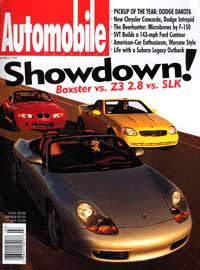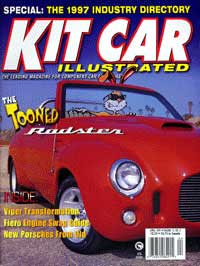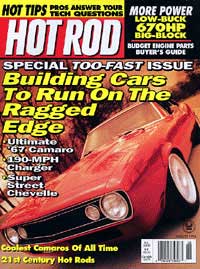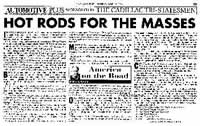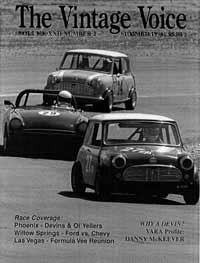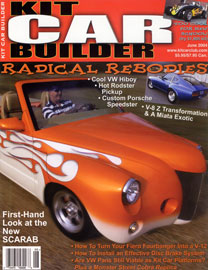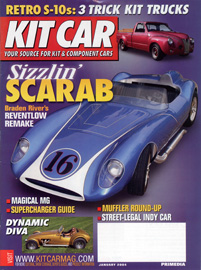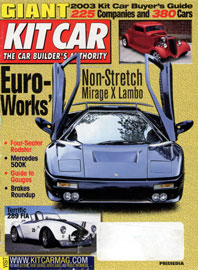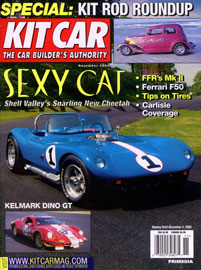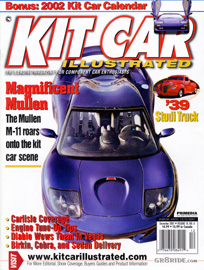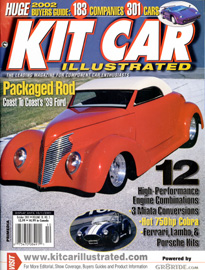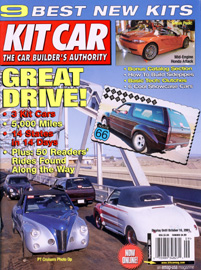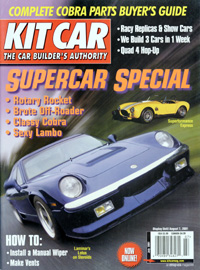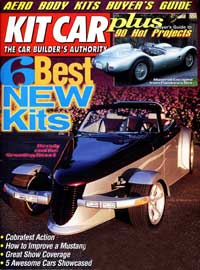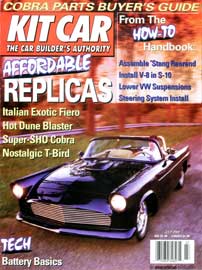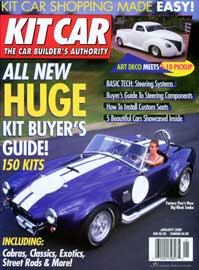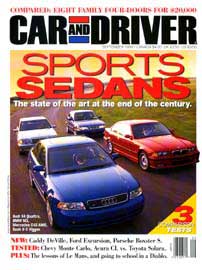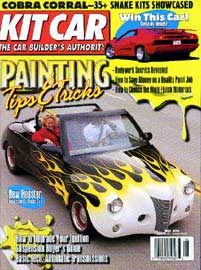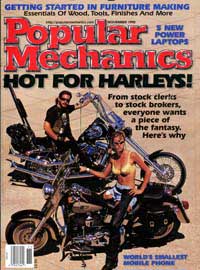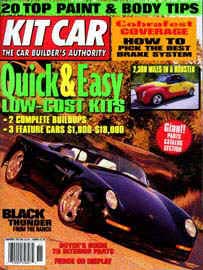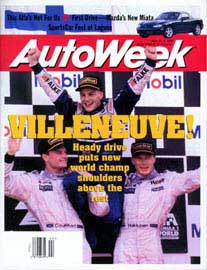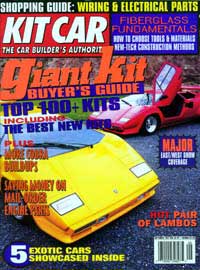What
is the Rodster®?
© Copyright Caroselli.
No images or text located anywhere on this site may be reused
or republished without expressed written permission from Rodster,
Inc., d.b.a.: Caroselli Design. The Rodster Street Rod design
is protected by
U.S. Patent # D450,284.
"Rodster®" is a registered
trademark of Caroselli Design. |
What is Kit Car Magazine saying about the Rodster® Street Rod?
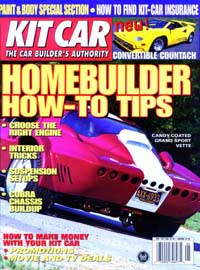 Kit
Car Magazine
Kit
Car Magazine
by Jim Youngs
Now here's a custom car that doesn't pretend to be something it's not. It's not a copy of anything, yet it has a very likable persona. It's a quasi-street rod, but without all the high-price-tag components, questionable reliability, and value that would preclude extensive use. It's a rebody that takes advantage of its modern donor platform and related components, but it transforms a vehicle you wouldn't give a second glance to into something nostalgic and with plenty of character.
The Rodster is the brainchild of Henry Caroselli, a talented designer with a background in award-winning advertising work for the Mazda RX-7, the Miata, and a stint at the Magic Kingdon. His ownership of some rather eclectic cars -- a '64 Lotus 7, '65 Lotus Elan, '50 VW Bug, and '52 Hudson Hornet -- over the years may explain some of the Rodster's novel look. Caroselli is a street-rod fan, appreciates vintage European sports cars, and has an affinity for musclecars. His intent with the Rodster was to design a cruisin' machine with several styling traits of historic automobilia and place it on a stout, modern chassis that would make the build easy and make the finished car reliable and dependable and a drive-anywhere looker.
Caroselli liked the fact that the Chevy S-10 Blazer ('82-'94) was produced in huge quantities and that the aftermarket was loaded with goodies to improve the suspension, increase the horsepower, and improve the shifting. The S-10 also was supported on a full frame ladder chassis with a front-engine/rear-drive configuration. You can get either an automatic or manual transmission and either the Iron Duke four-banger or a 4.3L V-6.
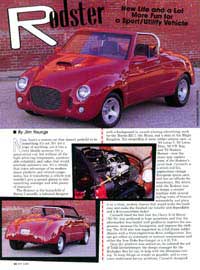
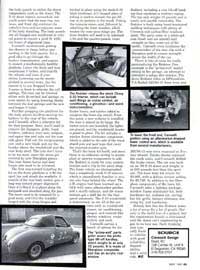
Once the platform was settled on, he enlisted the aid of Todd Gerstenberger, the design manager for the Brubaker Box kit car, to help with the fiberglass tooling. To keep things as simple as possible, and to overcome traditional kit-car problems, Caroselli designed the body panels to utilize the donor components such as the doors. The S-10 doors remain untouched, but you'll notice that the rear clip, tonneau, and front clip continue the vehicle's lines and incorporate some of the body detailing. The body panels are all flanged and reinforced at critical points to ensure a good fit without hours of alignment time.
Caroselli recommends getting the chassis in shape before proceeding to the body panels. It's a good idea to go through the brakes, transmission, and engine to ensure a mechanically healthy platform. Lower the front and rear suspension 3 inches, and trial-fit the wheels and tires of your choice. Lowering can be accomplished in several ways, but the easiest is to use dropped lower A-arms in front to relocate the coil springs. The rear can be lowered either with de-arched leaf springs, or even easier, by using lowering blocks between the leaf springs and the axle and longer U-bolts.
Further prepping the platform for the body pieces involves moving the battery to the rear of the vehicle, and Caroselli offers a relocator kit for that purpose. Next, you'll need to remove the bumpers, grille, hood, fenders, radiator, rear seat, tailgate, and spare tire and take out the rear side glass. Pull out the reciprocating saw and a new blade and cut the header above the windshield and the rear body shell. The cuts don't have to be too neat, since the areas get covered by new fiberglass pieces. The rear frame horns and door frame also need to be trimmed.
The first step toward installing the kit on the donor platform is to fit the sport bar and attach the seatbelts. A trial-fit of the rear body section goes a long way toward proper alignment. Once it is fitted, it is glued along the doorjamb and attached along the pan. The doors need to be trimmed for a good seam, and then the trunklid hinged with the strap hinges and latched in place using the stock S-10 latch hardware. A U-shaped piece of tubing is used to reroute the gas fill line to its position in the trunk. Fitting the tonneau comes next, followed by attaching the front crossbar, which locates the nose-piece hinge pin. The front fenders will need to be trimmed a bit and the quarter-panels, inner fender liners, and latches added to complete the front-clip install. From this point, a new radiator is installed, the nose is placed on its hinge, the rocker covers are installed, the lights are placed, and the windshield header is glued in place. The kit includes a window frame eliminator component, which is added to the side of the windshield post and post caps that cover the removed window post.
That's the basic kit build, and since there's no elaborate wiring to accomplish or interior components to add, the Rodster is ready for your custom touches and a trip to the paint shop. The demo vehicle we photographed had a completely stock S-10 interior, which is immediately familiar to anyone who hops behind the wheel. The 4.3L engine had been warmed up a little with some aftermarket goodies and a snarly exhaust, and the transmission got a shift kit for the four-speed automatic. The S-10 windshield is maintained, as are all of the systems such as windshield wipers, air conditioning, gauges, and controls like electric windows, cruise control, and such.
Caroselli carries a buch of options for the Rodster, including a new lift-off hardtop that emulates a roadster ragtop. The top only weighs 32 pounds and is easily and quickly removable. The Rodster is built using hand-laminated molding techniques with plenty of Coremat and carbon-fiber reinforcement. The parts come in a white-gel-coat finish and are smooth and straight as they come out of the molds. Caroselli even reinforces the crossmember of the rear clip with a fiberglass grid to ensure strength across the width of the car.
There is lots of room for really personalizing the Rodster. One example is the "prime-evil" model sitting in his garage, an attempt to interpret a jalopy dirt tracker. The demo Rodster rides on BFGoodrich T/A Radial 225/50-15 front tires and 265/50-15 rear tires mounted on five-star wheels. Tokiko shocks replaced the stock units, and Caroselli drilled the brake rotors. The car was built on an '89 S-10 donor and weighs in at 500 pounds less than the sport ute. The base body kit retails for $3,995, with a deluxe version selling for %4,795. In addtion to the fiberglass components of the basic kit, Caroselli adds a lighting package, window frame eliminator kit, body hardware kit, grille, battery relocator, lowering kit, and hoodscoop.
Rebody kits like the Rodster make a lot of sense for a lot of people. Not only is the build less of a project, but the registration hassle is eliminated, and the donor car's engineering is put to its best use. Such thinking also typically leads to vehicles with good reliability, dependability, and a solid ride.
